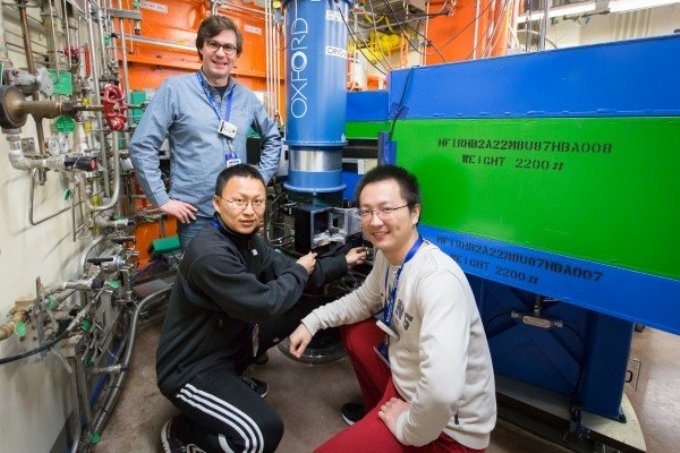Dec 22 2017
A research team including Georgia Institute of Technology professor Martin Mourigal used neutron scattering at Oak Ridge National Laboratory to study copper elpasolite, a mineral that can be driven to an exotic magnetic state when subjected to very low temperatures and a high magnetic field.
 Georgia Tech’s Martin Mourigal (left) and Xiaojian Bai (right), along with Florida State University’s Lianyang Dong (center), explore low-temperature quantum states in the mineral Cu-Elpasolite at HFIR beam line HB-2A. Credit: ORNL/Genevieve Martin
Georgia Tech’s Martin Mourigal (left) and Xiaojian Bai (right), along with Florida State University’s Lianyang Dong (center), explore low-temperature quantum states in the mineral Cu-Elpasolite at HFIR beam line HB-2A. Credit: ORNL/Genevieve Martin
A better understanding of the mineral’s magnetic moments and the associated quantum coherence effects could lead to new applications in spintronic devices and quantum computing technologies.
“Studying the behavior of magnetic materials in extreme conditions such as very low temperatures and high magnetic fields is important to obtain a better fundamental understanding of quantum materials, and to write the basic dictionary relating their microscopic structure to human-scale properties,” Mourigal said.
To reveal the material’s magnetic structure, the team used the Neutron Powder Diffractometer and Polarized Triple Axis Spectrometer instruments at ORNL’s High Flux Isotope Reactor—a DOE Office of Science User Facility.
Neutrons are well suited for investigating magnetic materials given their sensitivity to the organization and dynamics of electrons’ spins at the microscopic scale.
“The goal of this experiment was to understand the magnetic structure of the material below its 700 mK [millikelvins] transition,” Mourigal explained. “We know that spins talk to each other, but we don’t know what organized pattern they collectively choose or why.”
The researchers, led by project leader Art Ramirez at the University of California, Santa Cruz, recently published the results of their experiment in Nature Physics. The mineral sample was synthesized by Florida State University graduate student Lianyang Dong.
HFIR is a DOE Office of Science User Facility. UT-Battelle manages ORNL for the DOE's Office of Science. The Office of Science is the single largest supporter of basic research in the physical sciences in the United States, and is working to address some of the most pressing challenges of our time. For more information, please visit http://science.energy.gov/.—by Jeremy Rumsey